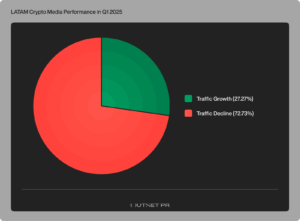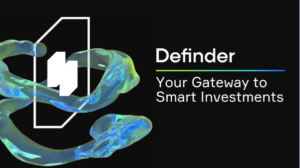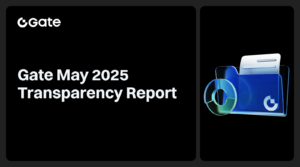
DID is short for Decentralized Identity, a digital identity without a centralized institution as the final guarantor. We can also understand it as an extension of the Web2 concept of “user profiling” in Web3.
The explosion of DeFi in 2020 has accelerated the development of blockchain applications and brought more and more users into the Web3 world. As a result, it has led to a high level of interest in projects dedicated to bridging the gap between the traditional and decentralized worlds, where the value of DID is beginning to be discovered.
With the improvement of the underlying blockchain infrastructure, blockchain technology is explored more towards implementation and the actual application of use. According to research, the decentralized identity market size is projected to grow to USD 6,822 million by 2027, at a Compound Annual Growth Rate (CAGR) of 88.7% during the forecast period.
This leads to the point that when massive incremental users enter Web3, there is a need for a trusted way for them to have a convenient tool to hold their rights and interests, so decentralized identity verification becomes the first choice, and because of this, projects in DID will have a high potential to become the holy grail of the future in blockchain.
The development of identity systems has not always been smooth. From the stage of centralized identity systems where single authority holds the data, to identity systems developed by individual platforms, then to accounts that can be synced to logged in, all in a continuous effort to provide a better experience and improve the deficiencies for users.
However, there is the argument that users are not in control of their personal data and potential exposure that leads to security concerns. In order to solve the problems brought by identity systems, the concept of decentralized identity, which combines identity authentication with blockchain, has taken the stage of history.
Decentralized Identity Horizon Arises. Who Is Leading The Way?
Decentralized identity allows individuals to manage their identity-related information. With decentralized identity solutions, users can create identifiers and claim and hold their attestations without relying on central authorities, like service providers or governments.
In a decentralised framework, DIDs are stored on distributed ledgers (blockchains) or peer-to-peer networks. This makes DIDs globally unique, resolvable with high availability, and cryptographically verifiable. A DID can be associated with different entities, including people, organizations, or government institutions.
ENS: The Industry Benchmark
In the 5 years since its launch, ENS has become the benchmark of DID. ENS domains have over 2.17 million total registrations, integrated on over 500 dApps, and over 500,000 independently held addresses. Domains can be set as primary domains, which can act as a user’s cross-platform Web3 username and profile.
Many celebrities and well-known brands are now using their ENS domain names as Twitter usernames, such as former NBA player Shaquille O’Neal (shaq.eth), Coinbase CEO Brian Armstrong (barmstrong.eth) and Ether founder Vitalik Buterin (Vitalik.eth ) etc. On the flipside, claiming and owning a domain name are expensive on ENS.
For example, for a 3-digit ENS domain name, users have to pay $640 per year to keep their ENS domain, which means they don’t truly hold their DIDs forever.
Unstoppable Domain: Freehold Domains
Unstoppable Domains has introduced “.crypto” top-level domains that can be owned forever through one-time purchase. Other suffixes from Unstoppable domains include .crypto/.nft/.x/.wallet/.bitcoin/.dao/.888/.zil/.blockchain.
Unstoppable Domains has a great advantage in browser integration, as it also supports almost all browsers supported by ENS. In addition, Unstoppable Domains has developed its own web browser (an open source version based on Chrome) to provide an even better user experience.
As of this year, its total domain name registrations were about 2.4 million and its total transaction volume was about $1.5 million according to trading data
KEY3.id: Industry First DID to Own Permanently For Free
KEY3.id is the industry’s first free to claim, free to own, free forever DID based on the Ethereum Chain. KEY3.id initially launched the .did domain and is supported by several wallets, including Bitkeep Wallet, KuCoin Wallet and CoinHub that can be used in scenarios such as transferring and receiving tokens, DeFi, GameFi, SocialFi, airdrop, etc. On top of that, KEY3.id also has premium DIDs that are ‘Asset Bound Tokens’ working together with Blue-Chip NFT communities.
For example, the holders of BAYC#0000 can claim 0000.bayc which adds another valuable identity factor to the DID. Currently, .bayc/.doodle/.mfer/.mimic are available for minting. Due to the support of major wallets,users can use their DIDs for cross chain transactions. Chains that support them include Ethereum, BSC,TRON,Polygon,BNB Chain and Solana.
The Dilemma of DID
By understanding the classification of DID, it is easy to see that different companies are exploring the possible future forms of DID. In many cases, DID itself is not the direct needs of users, although data ownership and privacy are very important to users, but these things are often not perceived by users in the intuitive experience of the product.
From a product management perspective, DIDs need to work on specific application scenarios if they are to be user-oriented. Imagine if you had no specific application to use your DID, regardless of the price and creativity of the naming system, users wouldn’t go to claim it.
There is one pain point worth mentioning, that currently most DID face portability problems as they are incompatible with each other. Providing a solution to this is actually one of the important points to make DIDs more user friendly and be applied massively.
Another issue derived is privacy protection. With the increase of various certifications and ratings, there will always be some information that users do not want to expose on chains that can be viewed at any time.
Of course, users would also not want this data to be placed in the centralized database, which would lose the meaning of DID in Web3. How to protect the user’s identity information and only let it be disclosed to the necessary situations is also a problem that DID has to face in the technical implementation.
There are still many projects that are deep into the technical solution of DID in order to have a greater breakthrough in security and technicality. To sum up, the DID track is still in the stage of growth and will lead to many innovations and adventures for Web3.
I’m a highly experienced and respected author in the field of Cryptocurrencies. I have written numerous articles and books on the subject, and my work is highly regarded by my peers. I have a strong understanding of the technology behind cryptocurrencies, and I am always up-to-date with the latest developments in the space. I am also an active investor in cryptocurrencies, and I have made a significant profit from investing in this new asset class. In addition to my writing and investment activities, I am also an active member of the cryptocurrency community, and I frequently speak at industry events.








